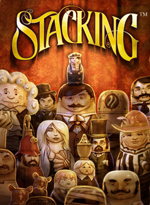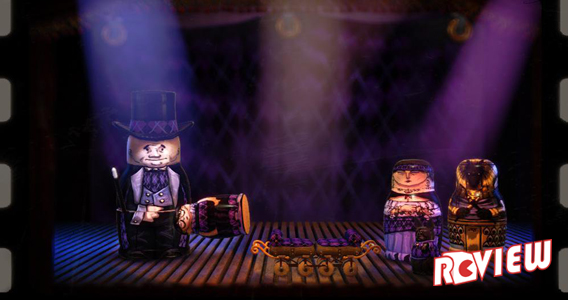
Stacking is one of those games that could only exist in the current generation of consoles—a labor of love the digital market allows for that, six or seven years ago, would have never seen release. In the vein of LittleBigPlanet, it often feels more like someone’s cute arts and crafts project than it does a videogame, characterized by sharp art and a carefully designed gameworld—however, in this instance the art unfortunately overwhelms the game, leaving the experience ultimately unengaging.
The player controls Charlie Blackmore, the youngest child in a family of chimney sweepers. The game begins as Charlie’s brothers and sisters are drafted as child laborers to pay the family debts; Charlie, too small to be of any use in such endeavors, is left behind, and embarks on a journey to reclaim his lost family. The story is told through silent-film style interludes, and the design here is impressively genuine—though the animation in these films largely consists of dolls shaking (to indicate speech), which becomes tiresome as the game progresses.
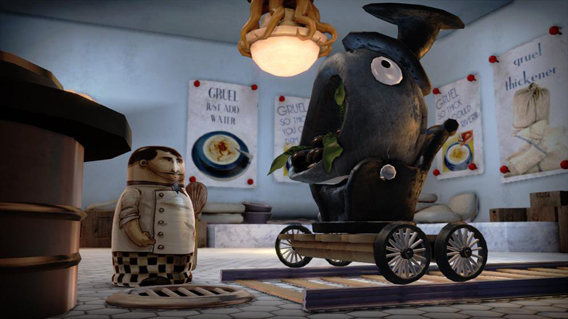
Charlie is a Russian matryoshka doll, the tiniest character in a gameworld populated with dozens of these unique, carefully crafted dolls. Charlie’s size grants him the ability to jump into any of these dolls, thus commandeering them for his own purposes.
Dolls have distinct personalities and abilities that can be used to accomplish particular goals; dolls will respond to other doll types differently, certain dolls will have access to special areas, and all dolls have an ability that can be used to achieve various effects. These talents are employed to solve a wealth of puzzles in Charlie’s journey to find his brothers and sisters, and defeat the evil Baron who has claimed them.
There’s a wide variety of dolls, with an impressive array of abilities. Several dolls can be stacked together, allowing for a distinct set of skills to be carried around at any one time, based on whatever obstacles the player expects to encounter. Some dolls are particular to specific areas, and these dolls are collectible—later showing up in the players secret hideout after they’ve been stacked into.
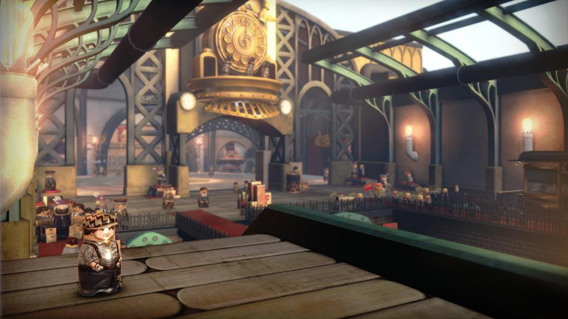
The variety, however, ultimately feels superficial, as every doll functions in exactly the same way—jump in, press A to activate that doll’s ability. Equally, the puzzles do not increase in complexity or challenge, ultimately causing the game to play the same from start to finish with no sense of progression or escalation.
Core puzzles all have multiple solutions, some of which are more obscure than others—so while it’s usually simple to solve each puzzle, it can be decidedly more difficult to find all of the available solutions. There’s some meat here for players looking to achieve maximum completion, but there’s no real impetus to complete such challenges; the puzzles are simply not very satisfying to solve, nor is the game very satisfying to play.
The fundamental problem is simplicity; Stacking is a pure puzzle game where every puzzle is solved by jumping into the correct doll, moving him into the correct position and pressing the A button. Besides this basic function, regardless of where the player is or what doll is being controlled, gameplay is limited to bobbing jerkily across the maps, looking for interactive elements and the dolls that can activate them. The problem is not merely that this becomes uninteresting later in the game, but that it’s largely uninteresting all the way through.
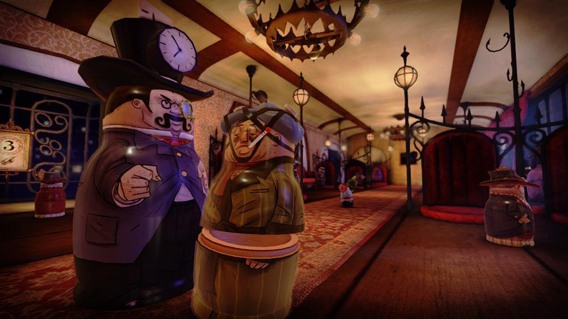
Perhaps the one sequence where the gameplay manages to change gears is the final battle with the evil Baron; this takes the shape of a Rock/Paper/Scissors game. Charlie Blackmore and the Baron each jump into dolls with rock, paper, and scissors abilities; the player is required to keep track of what play the Baron chooses, and quickly find a doll to counteract it as the Baron approaches. This isn’t particularly challenging—especially with the game allowing repeated failures—but what it offers is a scenario with demands that are entirely unique from the other challenges in the game.
The game is at its best in that one moment where it breaks away from the meandering puzzle mechanic and tries something different, demonstrating that the problem of Stacking isn’t technical, and it certainly isn’t artistic—it’s simply that the assets haven’t been built around an engaging play mechanic. It’s possible that one might find Stacking’s charming art, array of collectibles, and numerous puzzle solutions compelling—but sadly there simply isn’t enough game in this videogame.
Double Fine
Publisher
THQ
System
Xbox 360 (Xbox LIVE Arcade), PlayStation 3 (PlayStation Network) (Xbox LIVE Arcade Reviewed)
Modes
Singleplayer
Release Date
February 9, 2011
Price
1200 Microsoft Pts, $14.99
*A copy of this title was provided by the publisher for review
